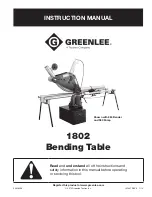
3.1.
Air Supply
3.1.1.
Ensure grinder air valve (or trigger) is in "off" position before connecting to the air supply.
3.1.2.
You will require an air pressure of 90psi, and an air flow according to specification.
3.1.3.
WARNING!
Ensure the air supply is clean and does not exceed 90 psi while operating the grinder. Too high an air
pressure and unclean air will shorten the product life due to excessive wear, and may be dangerous causing damage
and/or personal injury.
3.1.4.
Drain the air tank daily. Water in the air line will damage the grinder.
3.1.5.
Clean air inlet filter weekly. Recommended hook-up procedure is shown in fig 1.
3.1.6.
Line pressure should be increased to compensate for unusually long air hoses (over 8 metres). The minimum hose
diameter should be 1/4” I.D. and fittings must have the same inside dimensions.
3.1.7.
Keep hose away from heat, oil and sharp edges. Check hose for wear, and make certain that all connections are secure.
3.2.
Couplings.
Vibration may cause failure if a quick change coupling is connected directly to the die grinder.
To overcome this, connect a leader hose to the grinder. A quick change coupling may then be used to connect the leader
hose to the air line recoil hose. see fig 1 & 2.
3.
PREPARING TOOL FOR USE
4.3.
OPERATING
4.3.1. Connect the grinder to the air supply.
WARNING!
Ensure you have read, understood and apply safety instructions.
4.3.2. To start, hold firmly and push the trigger locking lever forward whilst depressing trigger.
4.3.3. The bit must be running at its maximum speed before attempting to grind the workpiece.
4.3.4. slowly and smoothly bring the grinding bit toward the workpiece (avoid jerky movements).
Exert adequate pressure on the grinder to grind according to the type and size of the material you are working with.
Avoid subjecting bit to excessive strain or harsh impacts.
Always hold grinder firmly and ease grinding bit against workpiece.
Maintain a controlled, adequate progression.
DO NOT allow grinder to free run for an extended period of time as this will shorten its life.
4. OPERATING INSTRUCTIONS
fig 1
fig 2
2.
INTRODUCTION & SPECIFICATION
One-handed straight type air angle grinder/sander. Use as either a grinder or simply insert the backing pad attachment to convert
into a sander. Includes various grinding points and 75/50mm sanding discs. supplied in carry-case.
4.1
FITTING grinding bit
WARNING!
Disconnect from the air supply before changing grinding bit.
4.1.1.
Check that grinding bits are not damaged in any way such as cracks, deformations or splinters etc. Damaged bits must
not be used.
4.1.2.
Use spanners provided to loosen collet locking collar. Insert appropriate collet and grinding bit and re-lock collar.
Collet size . . . . . . . . . . . . . . . . . . . . . . . . . . . . . 6mm/3mm
Disc size . . . . . . . . . . . . . . . . . . . . . . . . . . .Ø75mm/50mm
Free speed. . . . . . . . . . . . . . . . . . . . . . . . . . . . . 19000rpm
Air Consumption . . . . . . . . . . . . . . . . . . . . . . . . . . . .15cfm
Operating Pressure . . . . . . . . . . . . . . . . . . . . . . . . . . 90psi
Air Inlet size. . . . . . . . . . . . . . . . . . . . . . . . . . . . . . 1/4”BsP
Noise Power . . . . . . . . . . . . . . . . . . . . . . . . . . . . . . . 97dB
Weight . . . . . . . . . . . . . . . . . . . . . . . . . . . . . . . . . . . 1.64kg
. . .
Noise Pressure. . . . . . . . . . . . . . . . . . . . . . . . . . . . . . 87dB
4.2
FITTING sanding discs
4.2.1.
Make sure that the 6mm collet is inserted.
4.2.2.
Insert the sanding disc adaptor into the collet and tighten with spanners.
4.2.3.
Take the appropriate sanding pad and screw it clockwise onto the adaptor.
4.2.4.
screw on a corresponding sanding disc onto the sanding pad, turning it clockwise to secure.
Original Language Version
sA719 Issue: 3 - 16/12/11





















